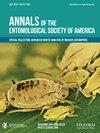与木犀碱Ambrosia Beetles相关的共生真菌(鞘翅目:Curculionidae:Scolytinae)及其全球合作的必要性
IF 1.8
3区 农林科学
Q1 ENTOMOLOGY
引用次数: 1
摘要
来自Xyleborini部落的Ambrosia甲虫几乎是所有森林生态系统的一部分。由于它们的体型小,单倍体的交配结构,以及在木本植物的边材内受保护的生命,它们具有通过无意的人类运输扩展到新地区的独特能力。少数入侵性木叶碱对森林、木材企业和农业系统造成重大损害。大多数木蛾害虫通过甲虫攻击的积累来破坏或杀死树木,其中一种已知通过将致病真菌引入易感樟科树木而导致树木死亡。蘑菇和甲虫载体之间的关系从互惠共生到兼性结合,但大多数仍未被研究。未解决的分类,趋同的形态,以及在其整个全球范围内取样的困难,使得对ambrosia真菌的全面调查难以实现。来自欧洲和北美的Ambrosia真菌有较好的记录,然而,我们还没有充分记录来自非洲、亚洲、澳大利亚和南美洲的Ambrosia真菌。为了更好地了解这些有影响力的生物,需要进行全球合作,以改进和规范对神仙藻共生的科学研究。本文章由计算机程序翻译,如有差异,请以英文原文为准。
Symbiotic Fungi Associated With Xyleborine Ambrosia Beetles (Coleoptera: Curculionidae: Scolytinae) and the Imperative of Global Collaboration
Abstract Ambrosia beetles from the tribe Xyleborini are part of nearly all forest ecosystems. Because of their small size, haplodiploid mating structure, and protected lives inside the sapwood of woody plants, they have a unique ability to expand into new regions via inadvertent human transport. A small number of invasive xyleborines cause significant damage to forests, lumber concerns, and agricultural systems. Most ambrosia pests damage or kill trees by the accumulation of beetle attacks, one is known to cause tree death through the introduction of pathogenic fungus into susceptible Lauraceae trees.The relationships between ambrosia fungi and their beetle vectors range from mutualistic symbiosis to facultative association, but most remain unstudied. Unresolved taxonomies, convergent morphologies, and the difficulty of sampling ambrosia fungi over their entire global ranges make comprehensive surveys of ambrosia fungi difficult to achieve. Ambrosia fungi from Europe and North America are moderately well documented, however, we have yet to sufficiently document those from Africa, Asia, Australia, and South America. Worldwide cooperation to improve and standardize scientific study of the ambrosia symbioses is needed to better understand these impactful organisms.
求助全文
通过发布文献求助,成功后即可免费获取论文全文。
去求助
来源期刊
CiteScore
4.90
自引率
0.00%
发文量
25
审稿时长
6-12 weeks
期刊介绍:
The Annals of the Entomological Society of America exists to stimulate interdisciplinary dialogue across the entomological disciplines and to advance cooperative interaction among diverse groups of entomologists. It seeks to attract and publish cutting-edge research, reviews, collections of articles on a common topic of broad interest, and discussion of topics with national or international importance. We especially welcome articles covering developing areas of research, controversial issues or debate, and topics of importance to society. Manuscripts that are primarily reports of new species, methodology, pest management, or the biology of single species generally will be referred to other journals of the ESA. The most important criteria for acceptance are quality of work and breadth of interest to the readership.

 求助内容:
求助内容: 应助结果提醒方式:
应助结果提醒方式:


